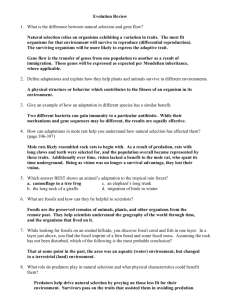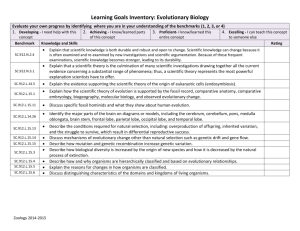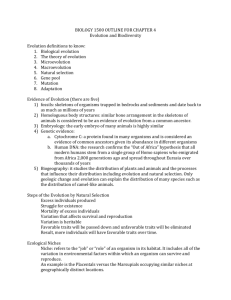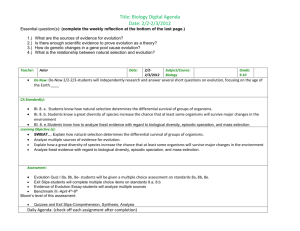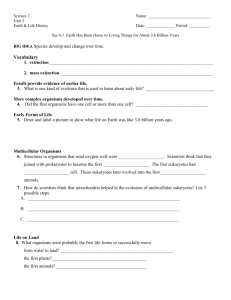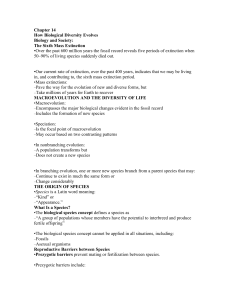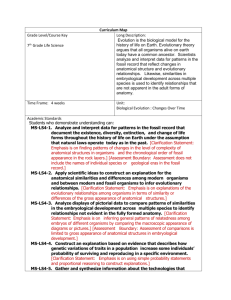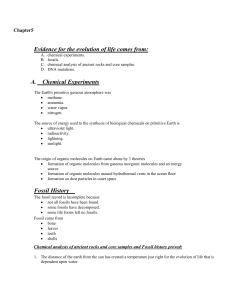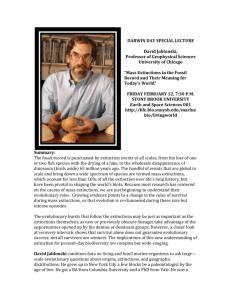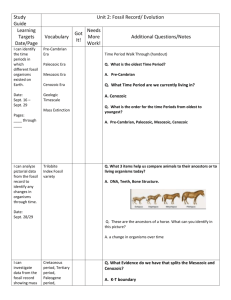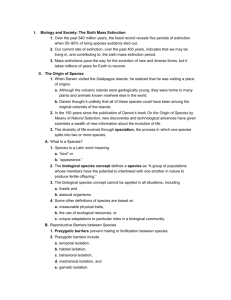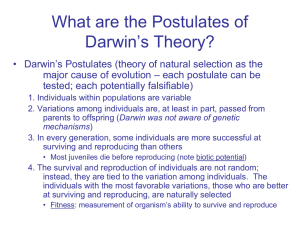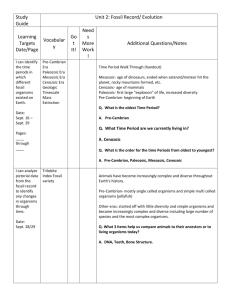Chapter 5—Evolution of Biodiversity
advertisement
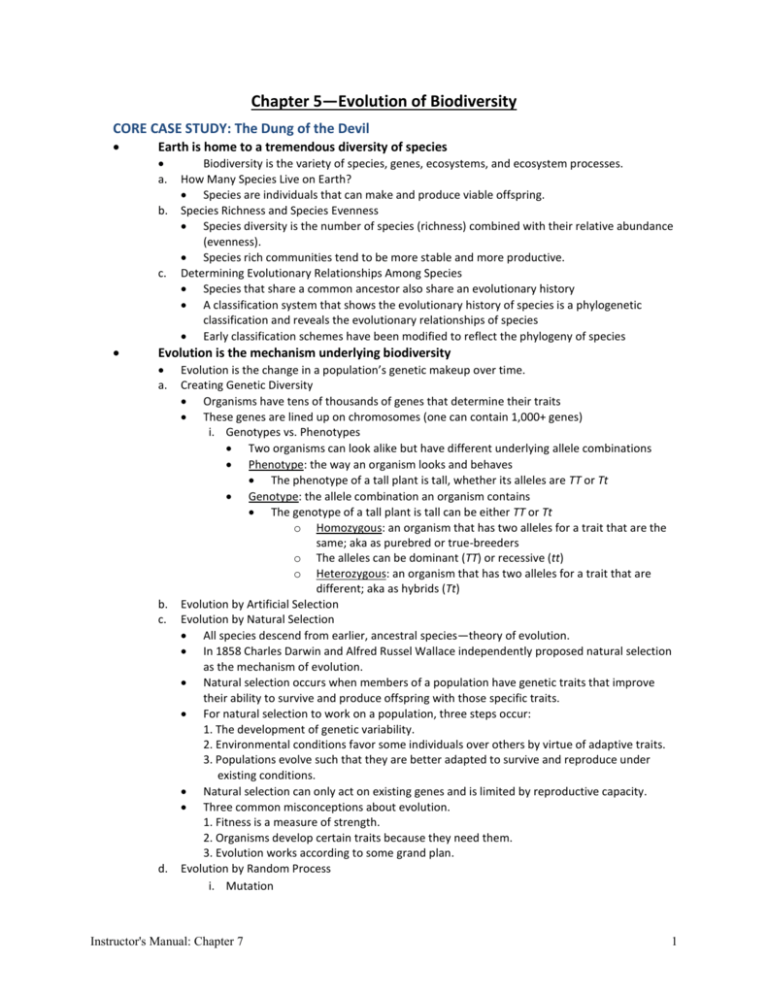
Chapter 5—Evolution of Biodiversity CORE CASE STUDY: The Dung of the Devil Earth is home to a tremendous diversity of species a. b. c. Biodiversity is the variety of species, genes, ecosystems, and ecosystem processes. How Many Species Live on Earth? Species are individuals that can make and produce viable offspring. Species Richness and Species Evenness Species diversity is the number of species (richness) combined with their relative abundance (evenness). Species rich communities tend to be more stable and more productive. Determining Evolutionary Relationships Among Species Species that share a common ancestor also share an evolutionary history A classification system that shows the evolutionary history of species is a phylogenetic classification and reveals the evolutionary relationships of species Early classification schemes have been modified to reflect the phylogeny of species Evolution is the mechanism underlying biodiversity a. b. c. d. Evolution is the change in a population’s genetic makeup over time. Creating Genetic Diversity Organisms have tens of thousands of genes that determine their traits These genes are lined up on chromosomes (one can contain 1,000+ genes) i. Genotypes vs. Phenotypes Two organisms can look alike but have different underlying allele combinations Phenotype: the way an organism looks and behaves The phenotype of a tall plant is tall, whether its alleles are TT or Tt Genotype: the allele combination an organism contains The genotype of a tall plant is tall can be either TT or Tt o Homozygous: an organism that has two alleles for a trait that are the same; aka as purebred or true-breeders o The alleles can be dominant (TT) or recessive (tt) o Heterozygous: an organism that has two alleles for a trait that are different; aka as hybrids (Tt) Evolution by Artificial Selection Evolution by Natural Selection All species descend from earlier, ancestral species—theory of evolution. In 1858 Charles Darwin and Alfred Russel Wallace independently proposed natural selection as the mechanism of evolution. Natural selection occurs when members of a population have genetic traits that improve their ability to survive and produce offspring with those specific traits. For natural selection to work on a population, three steps occur: 1. The development of genetic variability. 2. Environmental conditions favor some individuals over others by virtue of adaptive traits. 3. Populations evolve such that they are better adapted to survive and reproduce under existing conditions. Natural selection can only act on existing genes and is limited by reproductive capacity. Three common misconceptions about evolution. 1. Fitness is a measure of strength. 2. Organisms develop certain traits because they need them. 3. Evolution works according to some grand plan. Evolution by Random Process i. Mutation Instructor's Manual: Chapter 7 1 Mutations are random changes in the structure/number of DNA molecules in a cell. Mutations occur in two ways. 1. Gene DNA is exposed to external agents like Xrays, chemicals (mutagens), or radioactivity. 2. Random mistakes that occur in coded genetic instructions. ii. Genetic Drift iii. Bottleneck Effect iv. Founder Effect Speciation and extinction determine biodiversity a. Allopatric versus Sympatric Speciation Natural selection can lead to development of an entirely new species. In speciation, two species arise from one when some members of a population cannot breed with other members to produce fertile offspring. Speciation occurs in two phases: a. Geographic isolation, physical separation for long time periods. b. Reproductive isolation. In body cells of most plants and animals, chromosomes occur in pairs (one from mom, one from dad) Diploid: a cell with two of each kind of chromosome (2n) a. Organisms have two factors, called alleles, for each trait Organisms produce gametes that contain one of each kind of chromosome a. Haploid: a cell containing one of each kind of chromosome (n) b. Organisms with more than the usual number of chromosomes are called polyploids Polyploidy is rare in animals (usually causes death) but frequently occurs in plants (makes them larger and healthier) The Pace of Evolution i. Rate of Environmental Change ii. Genetic Variation iii. Population Size iv. Generation Time Evolution shapes ecological niches and determines species distributions a. b. Ecological niche is a species’ way of life in an ecosystem, everything that affects its survival and reproduction. Some species have broad ecological roles and are termed generalist species. Some species have narrow ecological roles and are termed specialist species. Niches can be occupied by native or non-native species. Indicator species provide early warning of ecosystem damage because they have a narrow range of tolerance. Keystone species have a large affect on maintaining balance within an ecosystem. a. Can be, but are not necessarily, pollinators and top predators. b. Foundation species create and enhance habitats that benefit other species. Environmental Change and Species Distributions Environmental Change and Species Extinctions When population members cannot adapt to changing environmental conditions, the species becomes extinct. a. Endemic species (those found in only one place) are especially vulnerable. When local environmental conditions change, some species will disappear at a low rate; this is called background extinction. Mass extinction is a significant rise in extinction rates above the background extinction level. Usually, 25–95% of species are lost. There appear to have been at least three and perhaps five mass extinctions on earth. i. The Fossil Record Instructor's Manual: Chapter 7 2 Most of what we know of the history of life comes from the fossil record. Paleontologists, scientists who study fossils, do not have a complete fossil record of ancient life. Fossils are hard to find and are vulnerable to weathering and erosion. Also, the soft bodies of some animals do not fossilize well. Most living things do not leave any trace of their existence, as the conditions necessary for fossil formation are rarely present when an organism dies. Using radiometric dating, scientists can often calculate a fossil's age. By pinpointing the age of fossils, scientists can reconstruct an evolutionary time line. Reconstructing the evolutionary history of a species can be difficult. Despite gaps in the fossil record, it reveals relationships between species and how their structures have changed over time. The degree of relatedness between two different species depends on how long ago they shared a common ancestor. In addition to using the fossil record, scientists compare species' anatomies to establish relatedness. ii. The Five Global Mass Extinctions Scientists estimate that Earth is currently home to between 5 million and 30 million different species. Ninety-nine percent of all types of organisms that ever lived on Earth are now extinct. iii. The Sixth Mass Extinction WORKING TOWARD SUSTAINABILITY: Burying the Oceans? Instructor's Manual: Chapter 7 3


